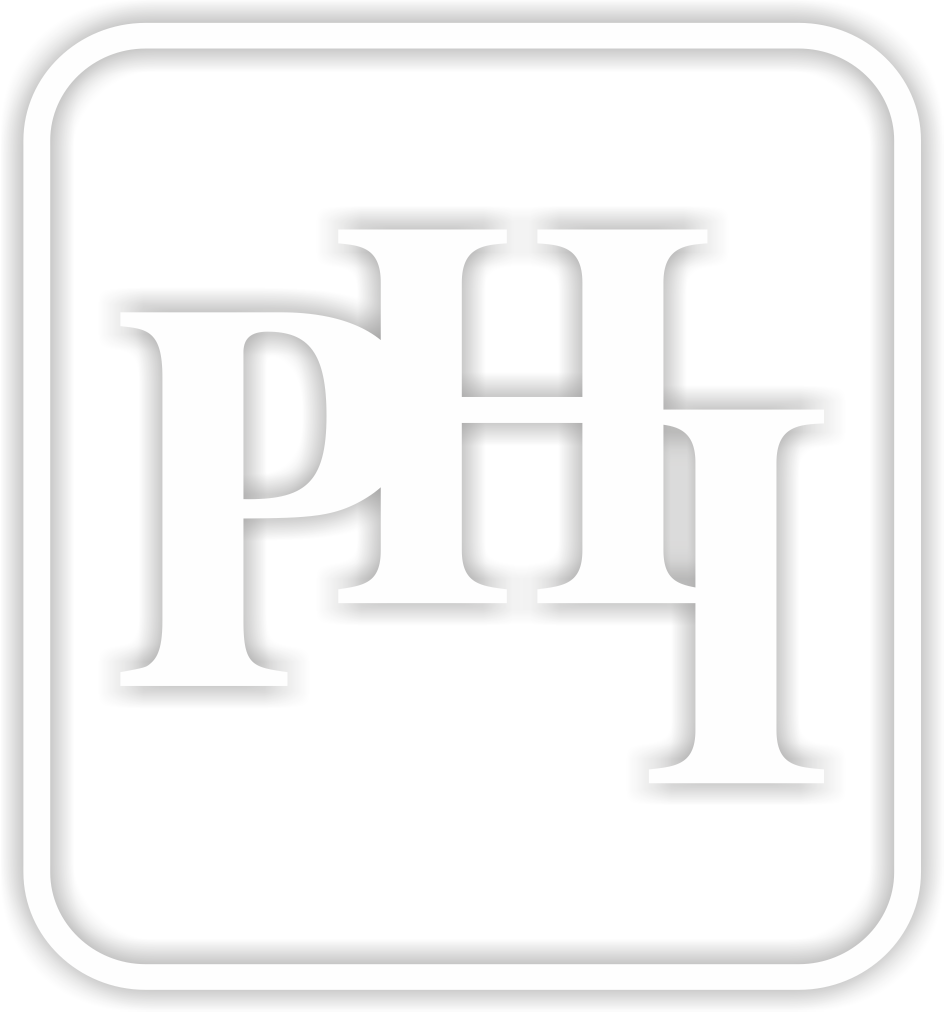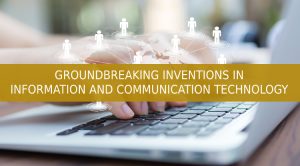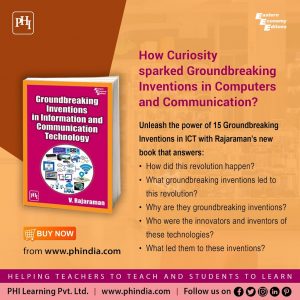Nowadays, Information and Communication Technology (ICT) touches every aspect of our life. When we get up in the morning, we check our smartphones for any missed calls, SMS, and WhatsApp messages that include audio clips, video clips, and sometimes computer-generated cartoons and animations. Many of us read the latest news and email on our smartphones, tablets, or laptop computers that are connected by Wi-Fi to the Internet. Researchers search the World Wide Web for relevant research papers using a search engine, usually Google. To hear an old favourite song, we turn to YouTube. Books are bought by logging on to Flipkart or Amazon and placing orders. Air tickets are booked by logging on to an airline’s or travel agent’s websites. Train tickets are booked on the IRCTC site. Banking is done from home using Internet banking. When we want to go out and need a taxi, we use Ola or Uber App installed in our smartphones to find out in a map where taxis are, and the time it will take to get one. The taxi driver uses his phone to find our location (found by GPS) from the map on his smartphone screen. The fare is automatically deducted from our pre-paid accounts with Ola or Uber. Else, we may use a digital payment App such as Paytm or BHIM. If the Internet cannot be accessed for some reason, it is extremely inconvenient as a lot of our work gets delayed. Undoubtedly almost everyone has become dependent on ICT in their daily life. ICT has spawned a number of new industries that employ millions of people. All this has happened in a relatively short period of about seventy years.
In a short span of seventy years, Information and Communication Technology has changed the way we live. Often, we wonder how we lived without the Internet and smartphones!
PHI’s recently released book GROUNDBREAKING INVENTIONS IN INFORMATION AND COMMUNICATION TECHNOLOGY by Rajaraman is written in a simple style without too many jargon terms to allow anyone with a pre-university education to understand and appreciate how ICT has developed.
What do we mean by a “Groundbreaking Invention”? Some of the meanings of the word “groundbreaking” taken from dictionaries are:
- “innovative, pioneering” (Oxford Dictionary)
- “A very new and big change from other things of its type” (Cambridge Dictionary)
- “Introducing new ideas or methods” (Merriam-Webster Dictionary)
- “Something innovative, pioneering or that has never been done before” (Your Dictionary)
Of these four meanings, the one given by the Merriam-Webster dictionary is closest to the criteria that are used to select the fifteen groundbreaking inventions presented in this book. What then are the criteria to classify an advancement in ICT as a groundbreaking invention? The following criteria are used:
- The idea should be novel.
- It should fulfill a need.
- It should improve our productivity.
- It should change the way in which computing is done, and computers are used.
- It should lead to innovations.
- The invention must have a long life and be continuously used and not be transient.
- It should create new industries that lead to further innovations and may, as a consequence, disrupt some old industries.
- It should transform the way we live and thereby result in societal changes.
Every groundbreaking invention doesn’t need to satisfy all the above criteria. If it meets a majority of these, the author of this book has classified it as groundbreaking.
The book identifies and explains fifteen groundbreaking inventions in ICT from 1957 to-date. The first chapter explains what is meant by the term groundbreaking invention and the criteria that have used to identify groundbreaking inventions. The second, third, and fourth chapters describe the inventions, how they were invented, and the biographies of prominent inventors. The biographies are given in Boxes. They may be skipped while reading about the inventions and read afterward to get an idea about the inventors and their careers. In the fourth chapter, concluding remarks are added that discuss whether there are some common features in the inventions and about the nature of the inventors and why they succeeded.
In this book, Dr. Rajaraman has described the following for each of these inventions:
- History of the invention
- A brief biography of persons who were associated with the invention
- Why the author considers the invention as groundbreaking
The inventions are grouped as follows:
- Between 1957 and 1974 (the first four inventions)
- Between 1975 and 1984 (the middle five inventions)
- Between 1985 and 2011 (the last six inventions)
- Each group of inventions is described in a chapter.
This book seeks to answer the following questions lucidly to a non-specialist general reader:
- How did this revolution happen?
- What groundbreaking inventions led to this revolution?
- Why are they groundbreaking inventions?
- Who were the innovators and inventors of these technologies?
- What led them to these inventions?
Fifteen groundbreaking inventions: Fortran, Integrated Circuits, Relational Database Management Systems, Local Area Networks, Personal Computers, Public Key Encryption, Computer Graphics, Internet, GPS, World Wide Web, Search Engines, Digitisation and Compression of Multimedia, Mobile Computing, Cloud Computing, and Deep Learning (AI) are described cogently by Professor V. Rajaraman, a doyen of Computer Science education and research in India.
TARGET AUDIENCE
- Students, academicians, professionals in the field of ICT
- Anyone who wants to know about ICT
V. RAJARAMAN – A Pioneer in the Field of Computer Science Education in India
Born: 8 September 1933, Madras Presidency, British India
Occupation: Computer engineer & Academic Author
Known for: Computer science academics and literature
Awards
- Padma Bhushan
- Shanti Swarup Bhatnagar Prize
- Om Prakash Bhasin Award
- Homi Bhabha Prize
- IIScRustomChoksi Award
- INAE Lifetime Contribution Award
- IISc Distinguished Alumnus Award
- CSI Lifetime Achievement Award
Vaidyeswaran Rajaraman is an Indian engineer, academic and writer, known for his pioneering efforts in the field of Computer Science education in India. He is credited with the establishment of the first academic programme in computer science in India, which he helped initiate at the Indian Institute of Technology, Kanpur in 1965. An elected fellow of all the Indian science academies, he is a recipient of the Shanti Swarup Bhatnagar Prize, the highest Indian award in the Science and Technology category for young scientists and several other honors including Om Prakash Bhasin Award and Homi Bhabha Prize. The Government of India awarded him the third highest civilian honour of the Padma Bhushan, in 1998, for his contributions to science.
He passed the Higher secondary examination as a student of the first batch of the Madras Education Association (now known as DTEA) Higher Secondary School, New Delhi, in 1949. V. Rajaraman was awarded a scholarship by the Delhi University after passing the All India Entrance Scholarship Examination and graduated with honors in Physics from St. Stephen’s College of the University of Delhi in 1952 and continued his higher studies at the Indian Institute of Science, Bangalore (IISc) to obtain a Diploma in Electrical Communication Engineering in 1955. He stayed on at IISc and designed and constructed non-linear units for an analog computer and applied it for solving a number of engineering problems for which he was awarded an associateship by IISc in 1957. He was awarded an overseas scholarship by the Government of India and joined the Massachusetts Institute of Technology, Cambridge from where he obtained his master’s degree in electrical engineering in 1959. Thereafter, he enrolled himself at the University of Wisconsin-Madison for his doctoral studies and did research on adaptive control systems and obtained a Ph.D. in 1961. He started his career as an assistant professor of statistics at the University of Wisconsin-Madison. In 1962, he returned to India to work as an assistant professor of electrical engineering at the Indian Institute of Technology, Kanpur (IITK). He went as a visiting assistant professor of Electrical Engineering at the University of California, Berkeley during the period 1965–66. It was during this time, he shifted his focus to the then-nascent discipline of computer science.
Supercomputer Education and Research Centre, IISc Bangalore
In early 1965, with the encouragement by Prof.H.K.Kesavan, the Head of Electrical Engineering Department at IITK, Rajaraman along with his colleagues, initiated a new MTech programme with Computer Science as an option; the first time the subject was being offered as an academic discipline in India. Later, he helped introduce a doctoral program, too, and the group led by him pioneered the use of decision tables in the development, debugging, and optimization of complex computer programs. He initiated the first B.Tech. programme at IITK in 1978 with an initial batch of 20 students. He became a senior professor at IITK in 1974 and stayed there till 1982. He moved to the Indian Institute of Science, Bangalore, and developed low-cost parallel computers and a supercomputing facility of which he served as the Chairman from 1982 to 1994. During his tenure at IITK and IISc, he guided 30 students in their doctoral studies. He published over 70 scientific papers in national and international peer-reviewed journals and several textbooks, including the first on computer programming published in India by PHI Learning Private Limited titled Principles of Computer Programming, Computer Programming in FORTRAN 90and 95, Computer Oriented Numerical Methods(Third Edition), Analog Computation and Simulation, Analysis and Design of Information Systems(Third Edition), Computer Basics and C Programming, Computer Programming in C, Computer Programming in FORTRAN 77 (With an Introduction to FORTRAN 90), 4th ed., Essentials of E-Commerce Technology, Introduction to Information Technology(Third Edition), Fundamentals of Computers(sixth edition), Parallel Computers—Architecture and Programming(Second Edition), Computer Organization and Architecture, Digital Logic and Computer Organization, an introduction to Digital Computer Design(Fifth Edition) among others. His Ph.D. thesis was on the Theory of parameter-perturbation adaptive and optimizing control systems, and S.M. thesis was on the Effects of Parameter Variations in Linear Amplifiers. He wrote a monograph, History of Computing in India: 1955-2010, on the invitation of the IEEE Computer Society in 2014. It details the history of Information Technology in India. Besides developing parallel computers, Dr.Rajaraman contributed in the development of real-time control system for Bhilai Steel Plant, designed the training modules for Tata Consultancy Services (TCS), and designed computer science curriculum for All India Council for Technical Education (AICTE), the national council for technical education in India. He was a member of the Electronics Commission during 1979–82. During his tenure in the Electronics Commission, he chaired a committee that recommended the introduction of a new academic programme called Master of Computer Applications (MCA) for BSc and BCom students foreseeing the impending human resource shortage for the IT industry. This was a unique program in India. He was a council member of the Indian National Science Academy (INSA) from 1986 to 1988. He served as a consultant to Bharat Electronics (BEL), TCS, Electronics Corporation of India Limited (ECIL), Steel Authority of India Limited (SAIL), and Kerala Venture Capital. He chaired a committee set up by the Science Advisory Council to the Prime Minister in 1987 that recommended establishing Centre for the Development of Advanced Computing (CDAC) to design and develop supercomputers in India using parallel computing technology. He was a member of CDAC’s governing council in its formative years. He was a Tata Chem professor at IISc from 1991 to 1994 and the IBM Professor of Information Technology at Jawaharlal Nehru Centre for Advanced Scientific Research (JNCAR) from 1994 to 2001. He was a member of the board of directors of CMC Ltd., Canbank Computer Services Ltd., Encore Software Ltd., and IIIT, Kerala. He was a member of the Technical Advisory Panel of the Government of Karnataka from 1985 to 2014. During his tenure, he advised the government on computerization of land registration (Bhoomi Project), Kaveri project of the stamps and registration department for computerising registration of urban properties, computerizing the court systems, and many important e-governance projects. His hobbies include listening to classical Karnatik and Western music and reading fiction and non-fiction books.
Awards and Honors
Rajaraman received Shanti Swarup Bhatnagar Prize, the highest Indian science and technology award for young scientists, in 1976, for his contributions in optimizing the use of decision tables and his pioneering work in computer science. This was followed by the Homi Bhabha Prize in 1984 and the Indian Society of Technical Education Award for Excellence in Teaching in 1988. He was awarded the Om Prakash Bhasin Award of the Shri Om Prakash Bhasin Foundation and RustomChoksi Award of the Indian Institute of Science in 1993. The Government of India included him in the Republic Day Honours list in 1998 for the civilian award of the Padma Bhushan. The Indian National Academy of Engineering honoured him with the Lifetime Contribution Award in Engineering in 2005, and he received the Distinguished Alumnus Award of the Indian Institute of Science in 2014. He has also delivered several award orations including the S.H. Zaheer Medal (1998) of the Indian National Science Academy. He is a recipient of the Lifetime Achievement Award of the Computer Society of India, Dataquest, and Systems Society of India. The Indian Academy of Sciences elected Rajaraman as its fellow in 1974 and the Indian National Science Academy and the National Academy of Sciences, India followed suit in 1982 and 1990 respectively. He is also an elected fellow of the Indian National Academy of Engineering and has held the fellowships of the Computer Society of India (1974) and the Institute of Electronics and Telecommunication Engineers. The Bengal Engineering and Science University and the Indian Institute of Technology Kanpur have conferred the degree of Doctor of Science (honoris causa) on Rajaraman.
An interview with Dr. Rajaraman is available at http://voxiitk.com/interview-with-dr-rajaraman/
The Series of Books by Rajaraman, published by Learning, is available for purchase from www.phindia.com.
The books are available in print book format as well as e-book format.



Leave a Reply